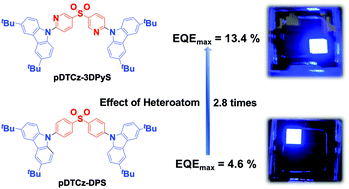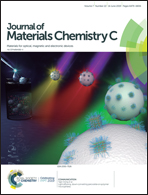Enhanced thermally activated delayed fluorescence through bridge modification in sulfone-based emitters employed in deep blue organic light-emitting diodes†‡
Abstract
Two thermally activated delayed fluorescence (TADF) emitters bearing a new dipyridylsulfone core as the electron-accepting unit and di-tert-butyl carbazoles as electron-donating units are reported. The two emitters, pDTCz-2DPyS and pDTCz-3DPyS, differ in the regiochemistry of the substitution about the pyridine rings [pDTCz-2DPyS = 9,9′-(sulfonylbis(pyridine-6,3-diyl))bis(3,6-di-tert-butyl-9H-carbazole); pDTCz-3DPyS = 9,9′-(sulfonylbis(pyridine-5,2-diyl))bis(3,6-di-tert-butyl-9H-carbazole)]. Both compounds show blue emission in the range of 450–465 nm, which is in line with theoretical calculations. They have very similar singlet–triplet energy (ΔEST) gaps (ΔEST = 0.22 eV and 0.21 eV for pDTCz-3DPyS and pDTCz-2DPyS, respectively). pDTCz-2DPyS has a much larger proportion of delayed emission (26.2%) than pDTCz-3DPyS (1.2%). The two compounds show comparable photoluminescence quantum yields of 60% in 2,8-bis(diphenylphosphoryl)dibenzo[b,d]thiophene (PPT) doped films. The performance of organic light-emitting diodes (OLEDs) depends on the host used. The maximum external quantum efficiency (EQE) in the PPT host of pDTCz-3DPyS is 7.0%, whilst for pDTCz-2DPyS it is 12.4%. High performance is obtained for both materials when bis[2-(diphenylphosphino)phenyl]ether oxide (DPEPO) is used as the host, with a maximum EQE of 13.4% for pDTCz-3DPyS and 11.4% for pDTCz-2DPyS, which is a significant improvement from 4.6% for the reference pDTCz-DPS. In addition, pDTCz-3DPyS shows pure blue electroluminescence with CIE color coordinates of (0.15, 0.12) compared to pDTCz-2DPyS with coordinates of (0.15, 0.19).

- This article is part of the themed collection: Functional Organic Materials for Optoelectronic Applications


 Please wait while we load your content...
Please wait while we load your content...